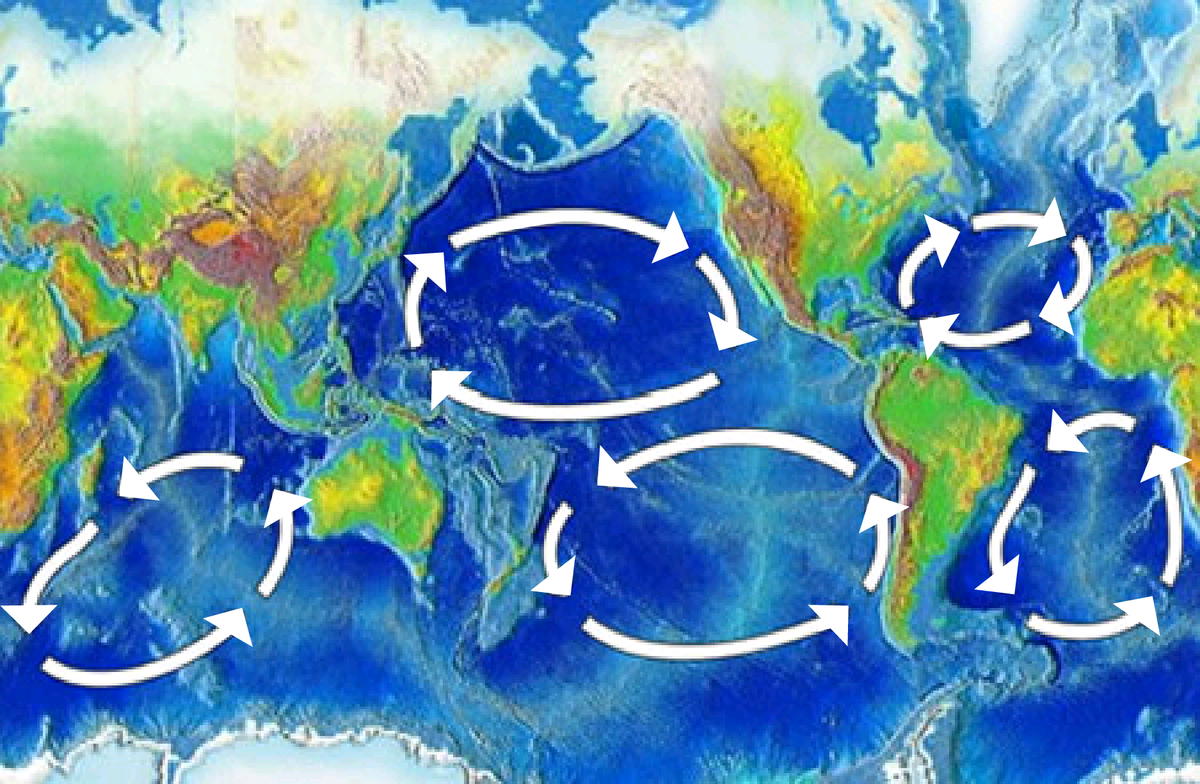Dans les océans, les courants marins forment des gyres, c’est-à-dire des tourbillons géants. Ces gyres sont situés à des latitudes moyennes et animés par les alizés[i], les variations de densité de l’eau et la force de Coriolis[ii].
Les déchets plastiques rejetés dans les océans par l’activité humaine sont naturellement entraînés par les courants marins et se concentrent, pour une partie, dans les 5 gyres recensées à ce jour : deux dans l’océan Atlantique, deux dans le Pacifique et un dans l’océan Indien. Dans le Pacifique nord, les chercheurs ont identifié 9 langues différentes sur les déchets étudiés et le plus ancien datait de 1977 !
Qu’est-ce qu’un gyre océanique ? – YouTube
Bien que le navigateur Charles Moore, qui fut l’un des premiers à parler de ce phénomène en 1997[iii], ait utilisé les termes de « continent plastique », ces zones d’accumulation ne sont pas constituées principalement de macrodéchets formant une île de déchets flottants. Elles concentrent surtout des microplastiques qui colonisent la colonne d’eau jusqu’à au moins 30m de profondeur et font plutôt penser à une « soupe de plastique ».
Les déchets plastiques se fragmentent en microplastiques par photo dégradation, abrasion mécanique et biodégradation[iv]. Sous cette forme, ils deviennent impossible à enlever de l’environnement.
Malgré les dizaines de milliers de milles nautiques parcourus autour du monde par les marins d’Ekkopol, aucun d’eux n’a donc pu observer ces fameux continents de déchets en mer: ces déchets sont entre 2 eaux et ne constituent pas des continents à proprement parlé. Impossible donc de les collecter simplement et leur dégradation lente représente un danger mortel pour la biodiversité.
En effet, les conséquences des microplastiques sont graves et probablement encore sous-estimées. On sait déjà aujourd’hui que l’ingestion de ces derniers par les organismes vivants engendrent la diffusion de polluants dans leurs corps et représentent un véritable danger pour l’ensemble de la chaîne alimentaire. Par exemple, les baleines sont contaminées par les phtalates[v], l’organisme photosynthétique le plus abondant sur Terre, la bactérie Prochlorococcus, est entravé dans sa mission de photosynthèse[vi] et l’ours polaire (encore lui) fait face à des difficultés de reproduction.
Par ailleurs, les gyres océaniques ne sont pas le seul cimetière des plastiques. Ces derniers s’y concentrent mais continuent également leur voyage ailleurs[vii]. Il est donc utopiste d’imaginer se contenter de collecter les déchets naturellement regroupés par la nature au milieu des océans. Ces déchets deviennent donc des « déchets ultimes » [x].
De fortes concentrations sont également relevées au large des régions industrielles et urbaines partout dans le monde. La Méditerranée concentre a elle seule 7% de tous les microplastiques de la planète[viii]. Emilien Pierron qui a navigué sur la mer de Java et le détroit de Malacca entre Bali et Port Kelang a observé une concentration de déchets dans l’eau qui l’a profondément marqué et qu’il n’a vu nulle part ailleurs lors de son tour du monde à la voile. En Antarctique, à proximité de la mer de Weddell où navigue régulièrement Geoffroy de Kersauson, Greenpeace a découvert en 2018 que sept prélèvements d’eau sur huit contiennent des microplastiques et sept prélèvements de neige sur neuf, des produits chimiques persistants connus pour causer des troubles du développement et de la reproduction chez les animaux[ix].

Les gyres océaniques, aussi utiles qu’elles aient été pour sensibiliser le grand public, ne doivent donc pas être considérées comme les seules zones marines polluées par les plastiques. Cette pollution est mondiale et encore trop peu étudiée. Ses conséquences sur les organismes vivants, dont nous faisons partie, sont encore méconnues et probablement sous-estimées.
Les Océans ne peuvent pas être nettoyés, réduisons donc nos déchets à la source et empêchons-les de prendre le large.
[i] Océan plastique, Nelly Pons, 2020, p. 65
[ii] The Ocean Plastic Crisis, Ellen MacArthur Foundation, 2016, p. 15
[iii] Ibid.
[iv] Accumulation of microplastics in the North Pacific Subtropical Gyre, Nature, 2018, p. 508
[v] Une partie d’entre eux sont classés comme « substances toxiques pour la reproduction »
[vi] Plastic leachates impair growth and oxygen production in Prochlorococcus, the ocean’s most abundant photosynthetic bacteria, Sasha G. Tetu, Indrani Sarker, Verena Schrameyer, Russell Pickford, Liam D. H. Elbourne, Lisa R. Moore, Ian T. Paulsen, 2019, p. 371-379
[vii] Océans, le mystère plastique, Vincent Perazio, 2016
[viii] Pollution plastique en Méditerranée, sortons du piège !, rapport du WWF, 2018
[ix] Microplastics and persistent fluorinated chemicals in the Antarctic, rapport de Greenpeace, 2018
[x] article L541-2-1 sur les déchets ultimes




No responses yet